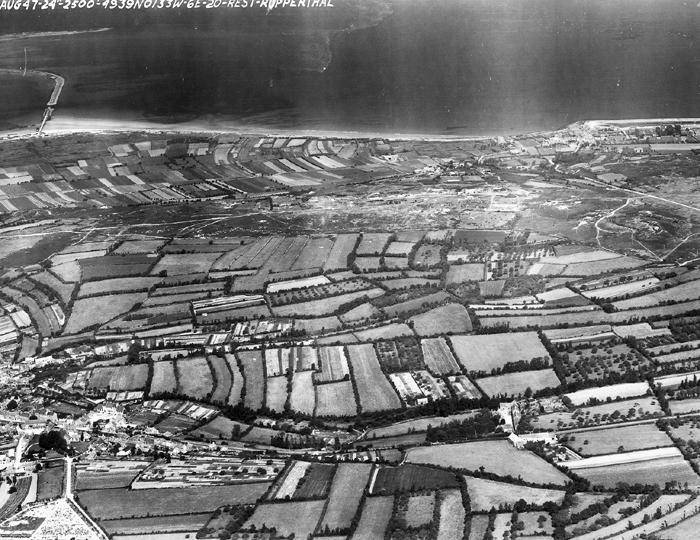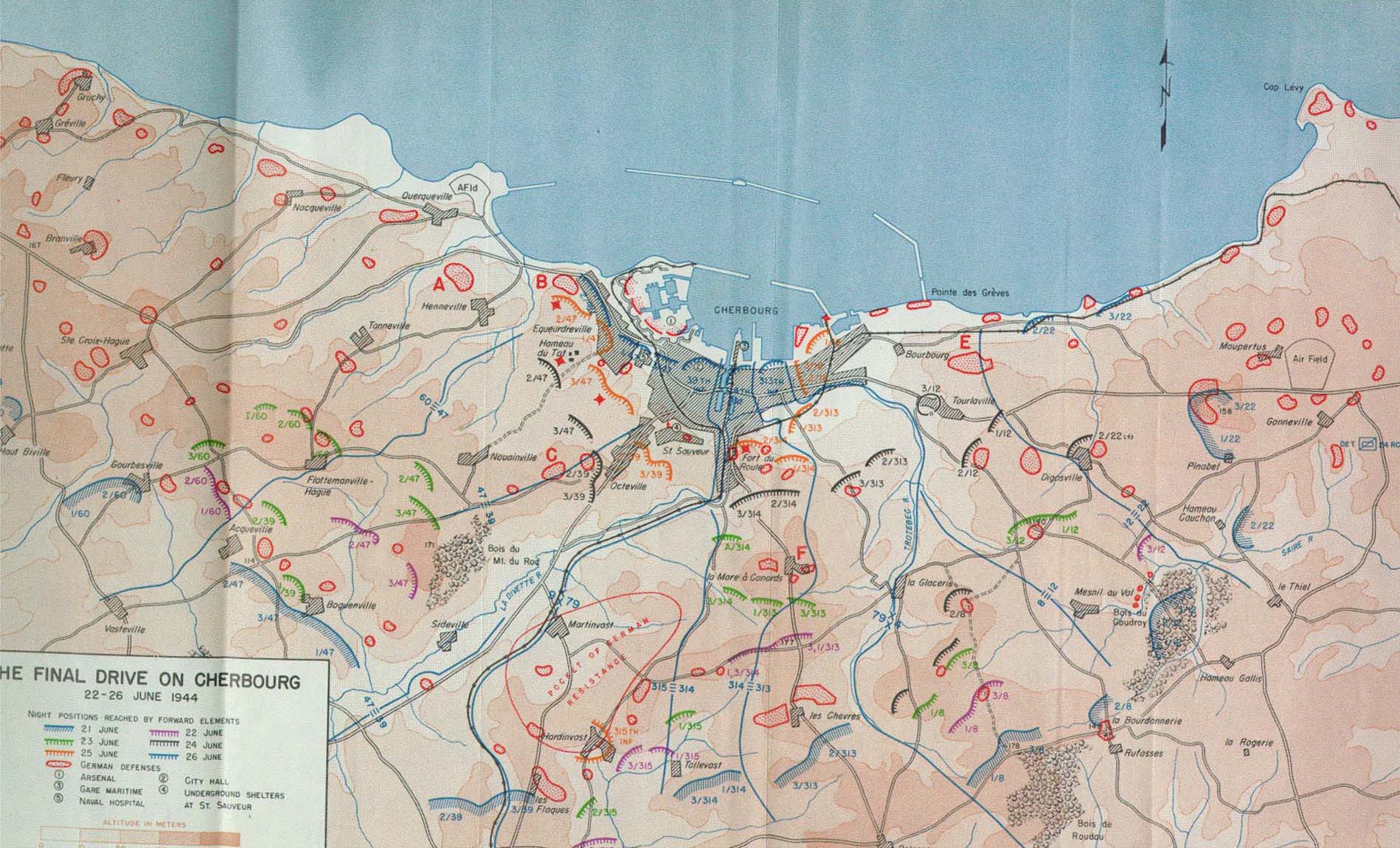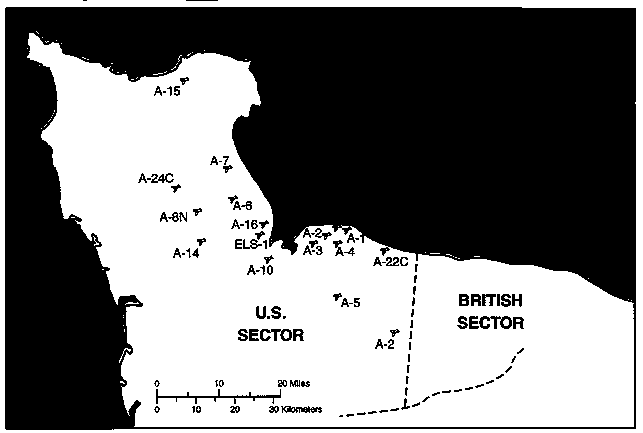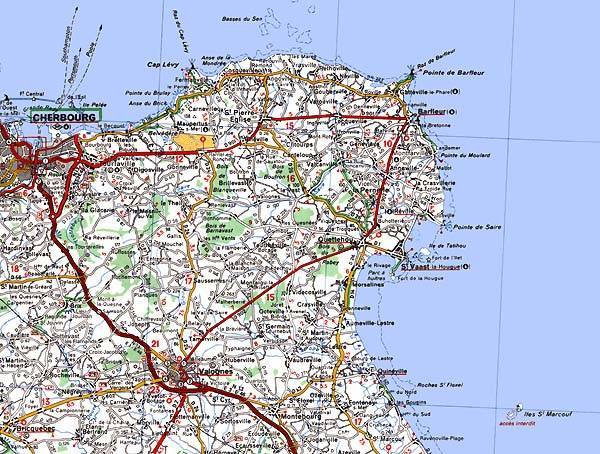 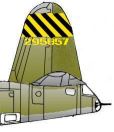 387TH
BOMBARDMENT GROUP (MEDIUM) 387TH
BOMBARDMENT GROUP (MEDIUM)
Station A-15
The Maupertus aerodrome, located five miles east of Cherbourg just outside the village of Maupertus-sur-Mer, was a Luftwaffe fighter base and an integral part of the defenses protecting Cherbourg from land attacks from the east. The aerodrome was captured by American
forces as part of the operations to capture the city of Cherbourg. On June
21 (D-Day plus 15) the 22nd Regiment of the 4th Infantry Division moved
to protect the right flank of the Corps attacking Cherbourg by cutting
off and containing the enemy in the Maupertus-Gonneville area. By June
26 resistance in Cherbourg was failing and the 22nd turned its strength
to the airport, attacking at 1100 hours from the south and east with three
battalions abreast and a troop of cavalry protecting each flank. Heavy
fire from enemy antiaircraft guns held up all three battalions for several
hours, but with the aid of supporting fire from the 44th Field Artillery
Battalion, the 1st Battalion took a series of positions south of the airport
and captured Gonneville, the 2nd Battalion occupied the western edge of
the field, and the 3rd Battalion captured Maupertus and the defenses along
the northern side of the field. The enemy, however, continued to offer
determined resistance and the airfield itself was not taken until the following
day.
The Allies had plans for the immediate
use of the airfield: it had been pre-designated Advanced Landing Ground
A-15 and the 834th Aviation Engineers were standing by to rehabilitate
it as soon as it had been secured. Within 48 hours of its capture the 834th
had laid more than 5,000 feet of pierced steel plank (PSP) over the grass
runways to make the airfield suitable for use by heavier aircraft and it
was immediately put to use despite the fact that a pile of bombs, shells,
duds and 600 mines lifted from the airfield still stood beside the runway.
Aircrews were billeted in prefabricated wooden barracks erected by the Germans and subsequently well-ventilated by allied air attacks. Trenches, barbed wire, tank barriers and pillboxes were much in evidence around the airfield, as were crates of German hand grenades and mortar shells. The edges of the roads were marked with many "Achtung Minen" signs. A burned out American Sherman Tank sat near the barracks and the charred remains of two of the occupants were clearly visible through the forward hatches. 363rd Fighter Group On June 30, 1944, the 9th USAAF's 363rd Fighter Group, flying P-38 Lightnings, arrived from Staplehurst. Dignitary visits Prime Minister Churchill landed at A-15 on July 20 when he came for a visit to the front; General Charles de Gaulle landed on August 20 for his return to France. 422nd Night Fighter Squadron and 225th AAA Searchlight Battalion The 225th AAA Searchlight Battalion defended the field in early August when it was the base of operations of the 422nd Night Fighter Squadron. The second platoon of Battery "A" also joined the Cherbourg defenses on 4 August, but was relieved by the first platoon of Battery "B" on 9 August when it was attached directly to the 422nd Night Fighter Squadron and took up positions around Airstrip A-15 at Maupertus. There were no direct attacks on A-15 by the Luftwaffe. Probably the most important development during this period was the introduction of the homing technique which was to play so large a part in the operational activity of the battalion during the remainder of the campaign against Germany. Until the assignment of the 2nd Platoon of Battery "A" to the 422nd Night Fighter Squadron on 9 August, occasional homings had been given on the beachhead airstrips by means of vertical beacon lights, but the instances in which such assistance was called for were rare. Upon assignment to the night fighters, however, the use of "the canopy" was begun, with three or four lights forming an intersection directly over the airstrip, enabling a friendly aircraft to pinpoint its location at great distances and despite unfavorable weather. The value of the service was immediately apparent to the 422nd Night Fighter Squadron and within a few days after the lights began to function in this role, the squadron commander expressed the opinion that the squadron would be unable to operate if the lights were removed. This squadron's unbounded enthusiasm soon spread to other night fighter squadrons and, eventually, to other branches of the Air Corps, until the service came to be in constant demand on practically every field to which this battalion was assigned. During the course of its travels across France and Germany, it gave almost 2,000 homings by the aid of which it is estimated that over 4,000 friendly aircraft were enabled to land safely. 387th Bombardment Group (Medium) The 387th Bombardment Group (Medium) arrived on August 22, the first medium bomber group to relocate across the channel. The flying elements flew in from Stoney Cross; ground personnel were landed at Utah Beach, climbed up the cliffs past the La Madelaine defenses that the aircrews had bombed just a few weeks earlier to the road and were trucked in. Due to the fequent rains, the sod under the landing mat was soft and the B-26s often didn't accelerate as rapidly as they normally would. Aircraft taking off toward the coast would sometimes dip down over Cherbourg harbor to pick up additional airspeed prior to joining formation; to the ground observer, flights would simply drop out of sight for a minute or two before reappearing several miles from the field. Timeline
|
